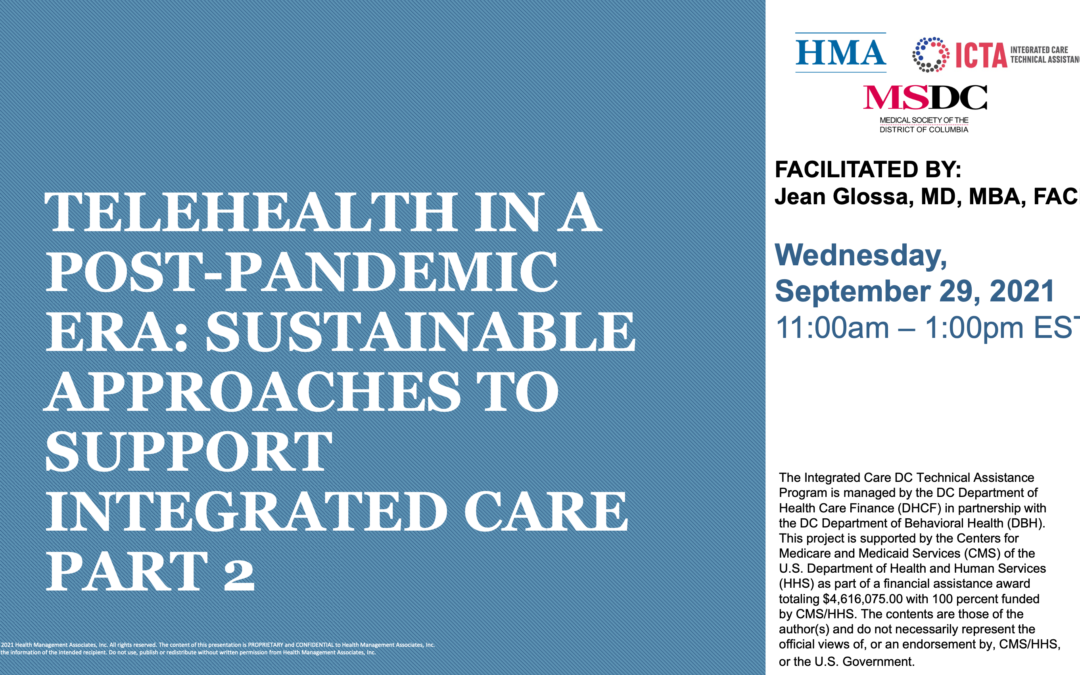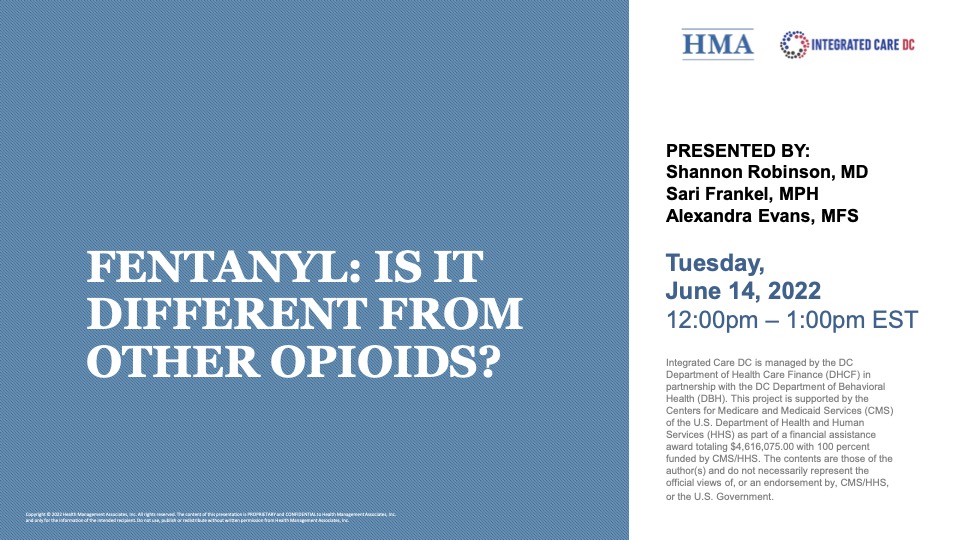

Understanding How and Why Providers and Payers are Using Incentive Payments as a Tool to Improve Integration (Understanding Primary Health Requirements for Incentive Payments Part 1)
We will talk with Dr. Yavar Moghimi, Chief Psychiatric Medical Officer of AmeriHealth Caritas about why integrated care is important and the ways AmeriHealth is working with providers to identify and ultimately achieve key physical and behavioral health outcomes. There will be time for audience questions and answers after a brief interview-style presentation.Help! We’re so Short Staffed: Best Practices for Hiring and Retaining Your Workforce
Vice President of Human Resources at Mount Sinai Health System in NYC and Dr. Mary Awuonda Associate Professor of Howard University and Dean Mashonda Smith of UDC will be share lessons learned in the district and other large health systems. The aim of the conversation is to talk and learn from one another to develop solutions grounded in the realities of the Washington DC policy, regulatory and health care environment.Providers Responsibility in Managing Medical Conditions: Making Clinical Improvements & Meeting Quality Metrics
What’s the link between pay for performance and healthy eating on a budget? What about the link between quality metrics and understanding nutrition labels? These are all related topics that providers and practices address every day! Care teams work 1:1 with patients to better manage their chronic diseases while at the same time, measuring and reporting outcomes that are related to payments and incentives. During this webinar, we will make the connection between patient engagement strategies and meeting quality metrics. This webinar is designed for ALL AUDIENCES as everyone has a role in providing high-quality care- from the exam room to the boardroom. Prior to the webinar, we invite you to view this short video “Bites on a Budget” created by HMA Senior Associate, Brandin Bowden, MSc., as he attempts to build a healthy dinner for under $5. In this #HealthyDinnerChallenge, Brandin puts on his nutrition educator hat to share healthful tips to help your patients and clients navigate the grocery store, increase nutrient intake and promote comfort in the kitchen.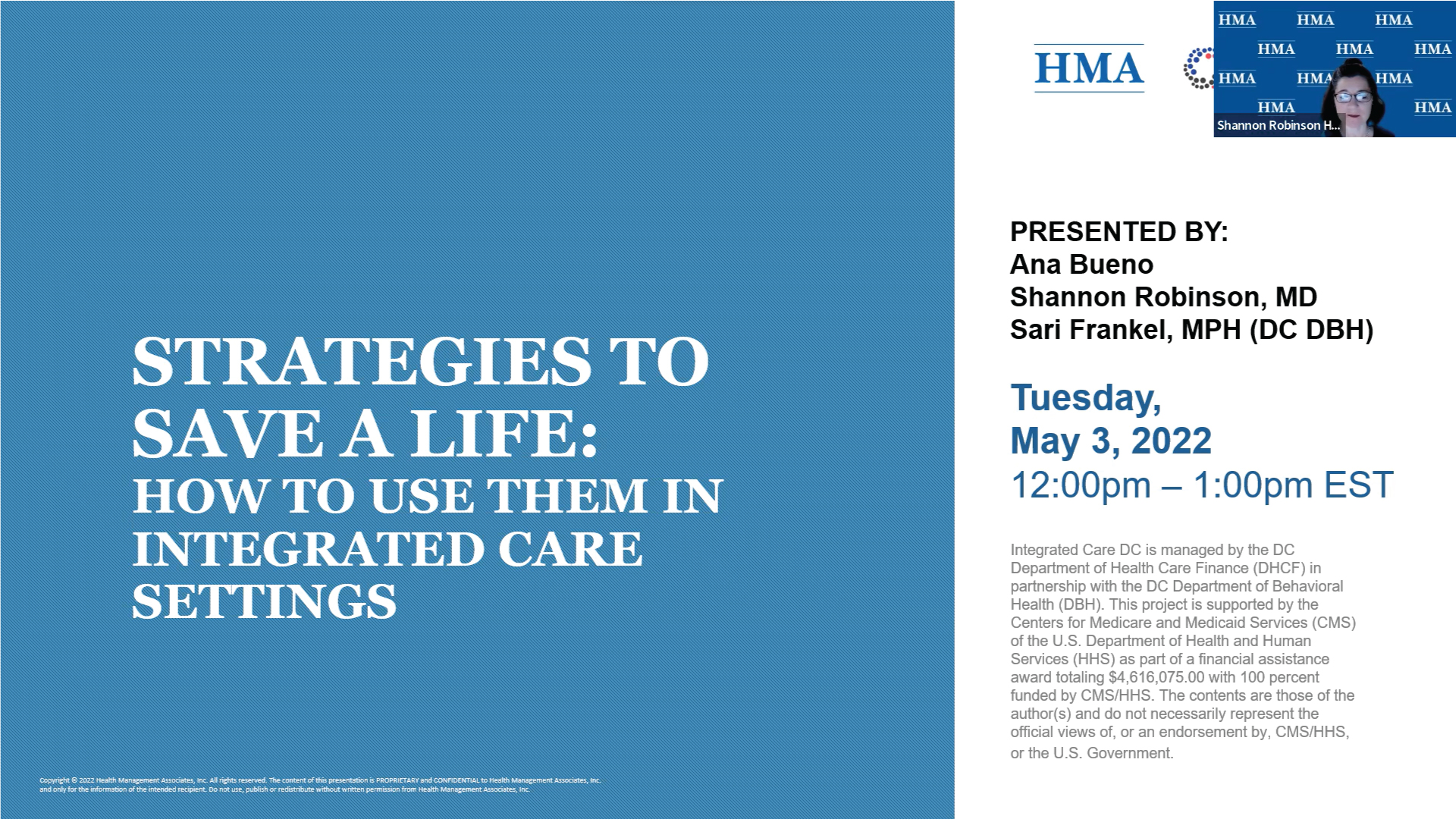
Harm Reduction Series Session 2: Strategies to Save A Life & How To Use Them In Integrated Care Settings
Health Management Associates invites you to join us for a lunch and learn workshop to learn more about Overdose Prevention and how to save a life in DC. In this interactive lunch and learn we will discuss DC’s Naloxone Distribution Program and the organizations currently providing Naloxone and provide: an overview of DC’s Standing Order and Samaritan Law an overview of the uses of opioids information on how naloxone stops an overdose and provide information on the action steps to take to save a life and stop an overdose. Where and how individuals can access naloxone, syringe services, and fentanyl test strips in DC.The Primary Care Behavioral Health (PCBH) Model of Integrated Care
The Primary Care Behavioral Health Consultation model (PCBH) is a psychological approach to population-based clinical health care that is simultaneously co-located, collaborative, and integrated within the primary care clinic. The goal of PCBH is to improve and promote overall health within the general population. This approach is important because approximately half of all patients in primary care present with psychiatric comorbidities, and 60% of psychiatric illness is treated in primary care. This webinar overs the framework of the PCBH model, the behavioral health consultant role, and a day-in-the-life look at integrated care using this model.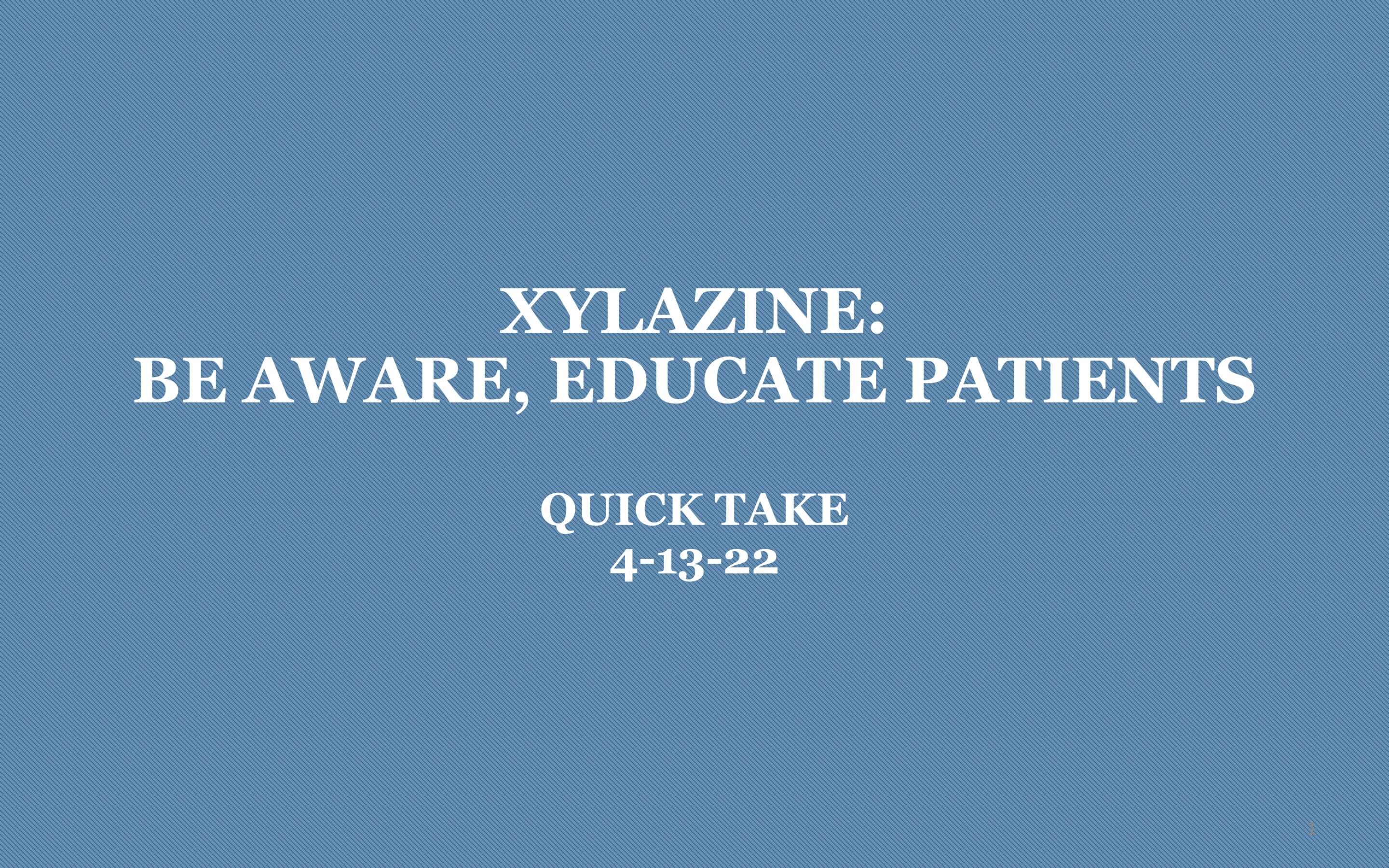
Xylazine: Dangerous Veterinary Sedative in Illicit Opioids (HMA)
Xylazine is rapidly increasing in the illicit drug supply. A powerful animal sedative, xylazine causes respiratory depression, bradycardia, and hypotension, raising the risk of overdoses and complicating the reversal of overdoses. Xylazine also causes unique skin lesions and risk for severe infections. This quick take gives basic information about xylazine.Perinatal Substance Use: Everything You Wanted to Know
Because many women and persons of childbearing age pregnant with SUD may not readily share information with providers and because pregnancy is a period where the motivation for change is extremely high, positioning providers to identify and care for this population has great potential for establishing a recovery path and changing lives. This webinar will review the risks and effects of SUD among women of childbearing age, pregnant and parenting persons and their affected infants, including screening and treatment considerations, breastfeeding decisions and ideal mechanisms for engagement and support of women and other pregnant persons on their recovery journey. We will also cover the short and long-term effects of SUD exposure on the infants, including non-pharmacologic alternative interventions and follow-up considerations.Short Take: A Day in the Life of a Behavioral Health Consultant in Primary Care: PCBH Workflow
The Primary Care Behavioral Health Consultation model (PCBH) is a psychological approach to population-based clinical health care that is simultaneously co-located, collaborative, and integrated within the primary care clinic. The goal of PCBH is to improve and promote overall health within the general population. This short take is part of a series titled: A Day in the Life of a Behavioral Health Consultant (BHC) in Primary Care. Viewers will see example workflows for initial and follow up BHC visits including where referrals come from, the steps involved with BHC intervention and closing the loop with the primary care provider.CCBHC Short Take: A Vehicle for Building & Sustaining Behavioral Health System Capacity
During this brief presentation, Kristan McIntosh, LMSW, shares an overview of what a Certified Community Behavioral Health Clinic (CCBHC) is, discusses why it is an important opportunity to build behavioral health system capacity, and talks about some upcoming opportunities to become (or partner with) a CCBHC.Mindfulness: An Evidence-Based Approach to Well-being
This short take demonstrates the use of mindfulness as a way to support stress reduction with your patients/clients. Mindfulness can be used in a wide variety of settings to help an individual get into the present moment and mitigate the effects of agitation and intrusive or racing thoughts. Mindfulness should be taught as a practice to rather than a one-time skill in order to obtain the maximum benefit. Mindfulness is a practice that has been incorporated into many treatments for depression, anxiety, and post-traumatic stress disorder and has been used with success to support individuals coping with the effects of chronic disease.Integrating Screening for Drug Use in General Medical Settings
Universal screening is key to successful detection of who needs further assessment. Additionally most providers are unaware of the power a brie intervention can have or that what they may already be doing with their patients has an evidence base to support it. This webinar will review the difference between screening and assessment and will demonstrate screening, brief intervention and referral to treatment , referred to as SBIRT. We will also review the evidence base for SBIRT and talk to a DC provider who has implemented training on SBIRT in their clinic.Cooking Healthy Meals at Home
Help your patients navigate the barriers to healthy home cooking such as time, comfort, cost, and navigating the Supermarket.Building the Foundation of a Healthy Diet
Share these foundational tips to help your patients think about ways to incorporate more healthy foods into their diets.Start With One Thing
Help your patient's identify goals and create a plan to shift their eating habits.Building a Healthier Plate
Help your patients take charge of their health by becoming more aware of their relationship with the food.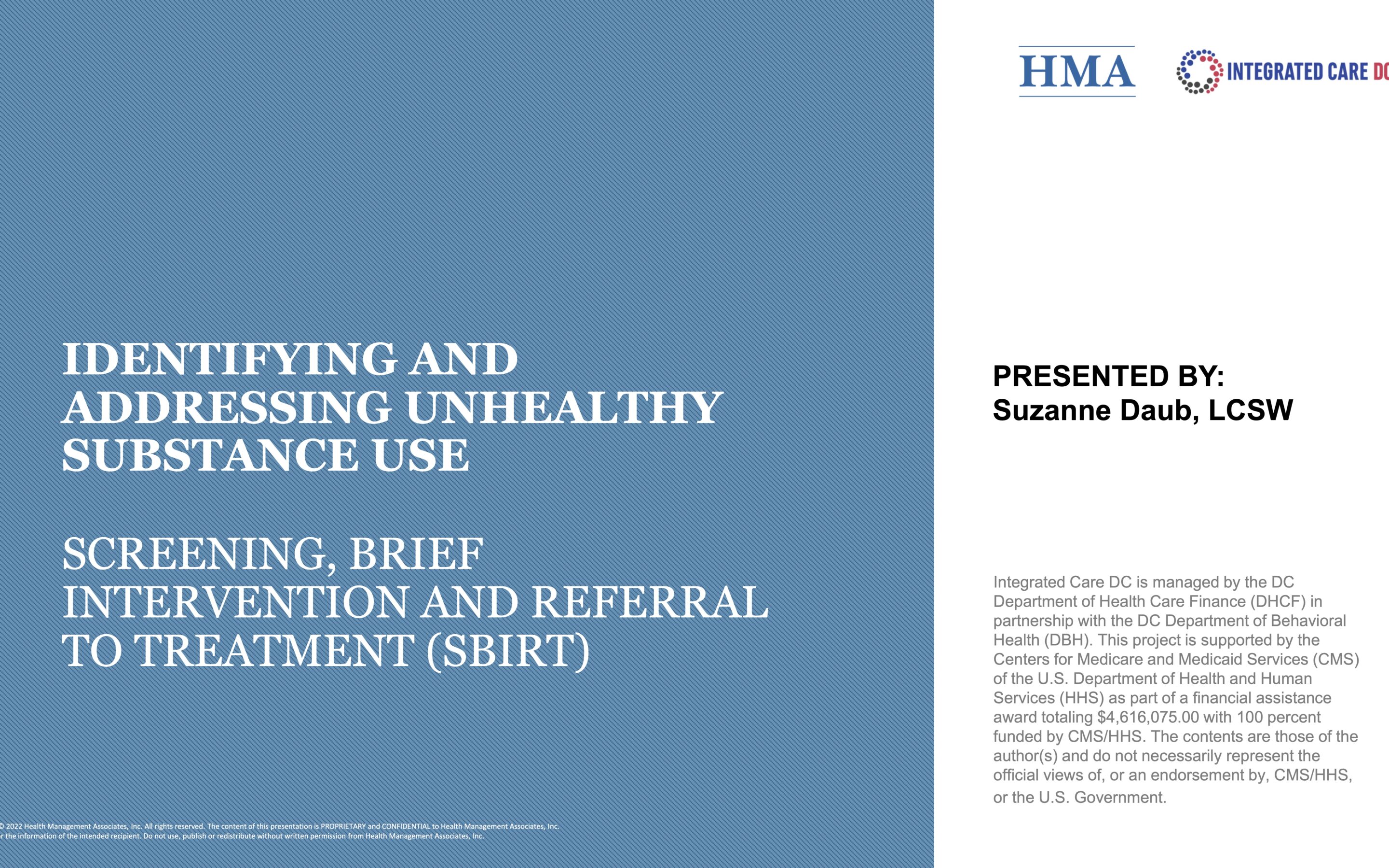
Screening, Assessment and SBIRT
This short take covers the basic concept of the Screening, Brief Intervention, Referral to Treatment (SBIRT) model. It reviews the reasons for why this approach is important, where SBIRT is delivered. Finally, each component of the model is briefly described.Bites on a Budget
Tag along with HMA Senior Associate, Brandin Bowden, MSc., as he attempts to build a healthy dinner for under $5. In this #HealthyDinnerChallenge, Brandin puts on his nutrition educator hat to share healthful tips to help your patients and clients navigate the grocery store, increase nutrient intake and promote comfort in the kitchen. This video was originally shared at the Johns Hopkins Urban Health Institute's 2021 Social Determinants of Health Symposium.How to Mitigate Workforce Burnout & Fatigue
Even before Covid health care workers were expressing burn out and exhaustion. Covid realities have made this worse. Not only are staff working overtime, they are worried about putting themselves, their families and patients at risk every day. Covid concerns come at a time when healthcare providers are dealing with a lot of unknowns. The healthcare system is changing and providers are faced with the continuous need to adapt to new and innovative practice approaches and payment strategies. It’s no wonder everyone is feeling exhausted! This webinar will give time and space to talk about how to support staff and increase satisfaction and joy at work while still working in a tumultuous time.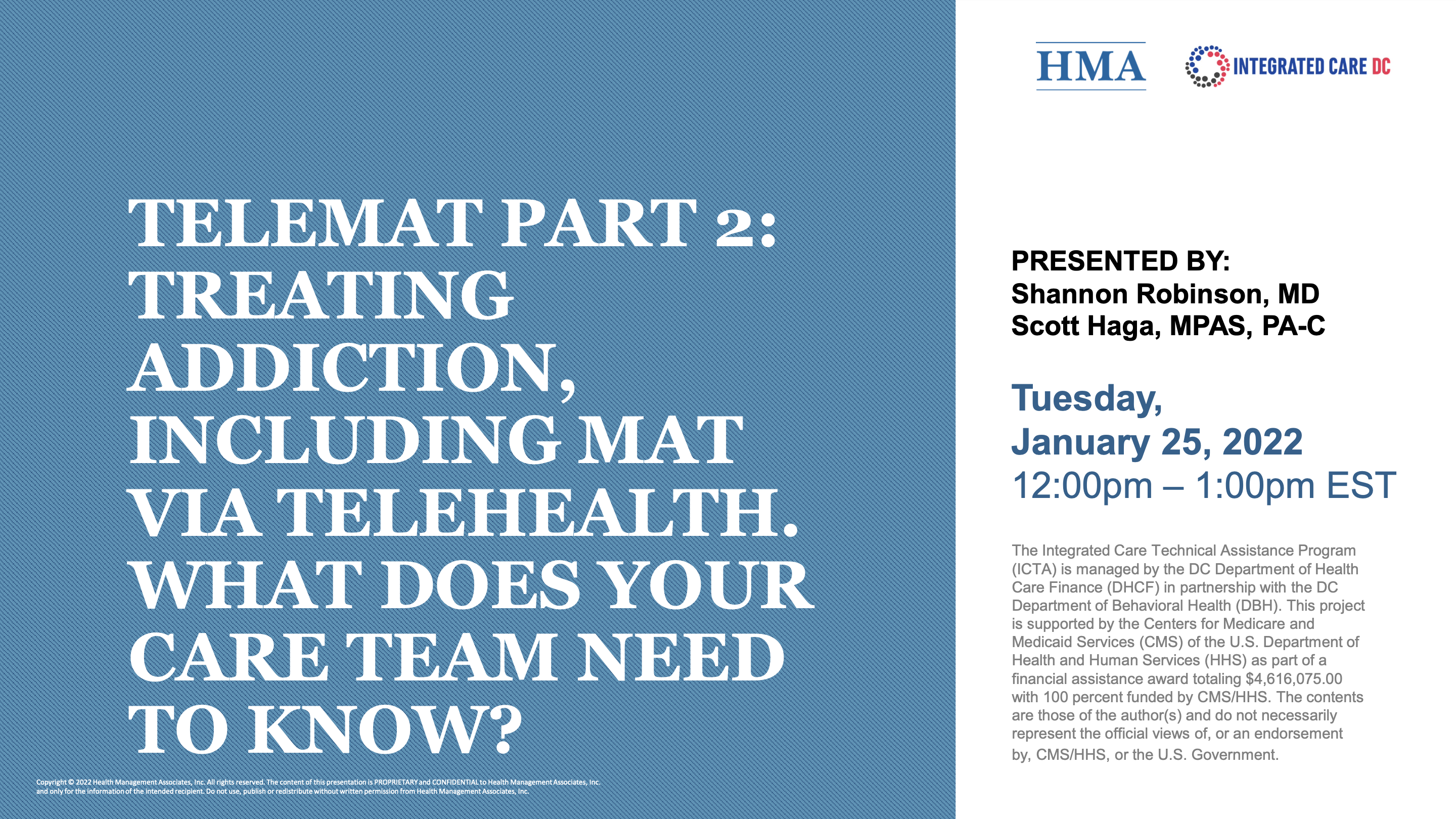
TeleMAT Part 2: Treating Addiction, Including MAT via Telehealth
Starting treatment for substance use disorders, like other medical and mental health conditions, requires close follow-up while stabilizing patients, followed by less frequent follow-up after stabilization. The frequency of visits can present an unnecessary barrier to getting care, which can be partially overcome by providing telehealth services. Regulations surrounding Medications for Addiction Treatment have been relaxed compared to years past and now allow for use of telehealth services. We will review the regulations around behavioral health (BH) and substance use disorder (SUD) treatment. Part of the regulatory changes now allow for buprenorphine to be prescribed over telehealth and it is important to become comfortable with the standard of care of home induction of buprenorphine. During this webinar, we will also discuss patient engagement and outcomes for both virtual individual and group treatments. This is the second webinar in a two-part series on Tele-MAT. We will hear from Tele-MAT grantees about their programs, successes and lessons learned during part 1 on January 11, 2021, 12:00pm – 1:00pm ET.MAT and Tele MAT Pre Appointment Self Assessment
This one-page self-assessment can be utilized before individual or group MAT appointments; this tool aligns with ASAM criteria allowing the provider to plan for the current session and to aid in treatment planning. With a slight modification, this could also be used by persons not on MAT in preparation for individual or group appointments for substance use disorders. Critical questions required for all telehealth appointments are reviewed, such as the address and phone number where the person can be reached today.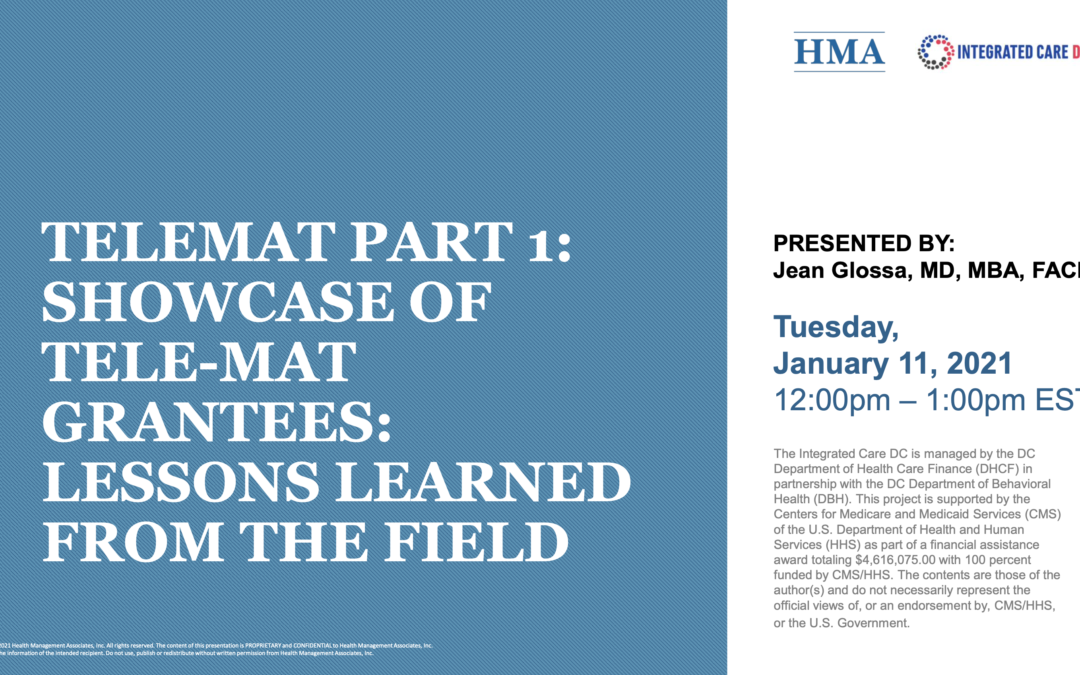
TeleMAT Part 1: Showcase of Tele-MAT Grantees: Lessons Learned From the Field
The Department of Health Care Finance (DHCF) awarded grants to local organizations to support new telehealth services for residents in Wards 7 and 8 as well as residents of homeless shelters and public housing developments. These projects connect patients to specialists using interactive audio, video, or other new technology. DHCF also awarded grants to local organizations to support telemedicine services among the District’s medication-assisted therapy (MAT) network of providers, including providers authorized (“waivered”) to treat opioid dependency with buprenorphine. During this session, we will hear from the three Tele-MAT grantees about their programs’ successes, challenges and lessons learned. An overview of Tele-MAT will be provided in part 2 of this series on January 25, 2021, 12:00pm - 1:00pm ET.Virtual Best Practices for Providers and Care Team Members
The front of this handout reviews what providers need to know, do and have a plan for prior to individual or group telehealth sessions. The back of the handout reviews important features of Zoom (TM) for those staff using Zoom (TM) as a platform for delivering telehealth sessions.Buprenorphine Outpatient Prescriber Information
This one-page handout is designed for busy outpatient providers who wish to start a patient on buprenorphine but need guidance on what to do before, important things not to forget when starting, how to monitor patients on buprenorphine, what to do if the patient is or is not doing well and duration of treatment.Patient Guide to Starting Buprenorphine
This one-page handout will help patients understand when they will start buprenorphine, based on the last time they used opioids and their current level of symptoms. It describes how to take buprenorphine in order for it to help with cravings and withdrawal symptoms, what dose of medication to take when starting and afterwards, and other important information about buprenorphine.Integration During Pregnancy-With an emphasis on Pregnant People Who Are Using Drugs
This short take talks about the added importance of building trust and integrating culturally and linguistically evidence-informed social, physical and behavioral health services during pregnancy. The short take place particular emphasis on pregnant people who use drugs because historically stigma, racism and other isms have often meant their care has not been clinically appropriate.Clinical Guidance for Treating Pregnant & Parenting Women With Opioid Use Disorder & Their Infants
This Clinical Guide provides comprehensive, national guidance for optimal management of pregnant and parenting women with opioid use disorder and their infants. The Clinical Guide helps healthcare professionals and patients determine the most clinically appropriate action for a particular situation and informs individualized treatment decisions.Well-Being & Resilience for Health Care Professionals
Through the Action Collaborative on Clinician Well-Being and Resilience, the National Academy of Medicine argues that patient well-being is predicated on the clinician-patient relationship. The clinician’s well-being will highly influence the clinical encounter. The research base points to organizational and practice environment factors (among others) on the system side of the equation and personal factors, skills and abilities, on the clinician side of the equation for optimal clinician resilience. The past two years of clinical teams working under extraordinary COVID-19 circumstances have taken a heavy toll on clinician resilience and well-being, not to mention on resulting quality and safety of care. This presentation explores the National Academy of Medicine model, focusing on clinician factors in well-being. Together, in an experiential and participatory presentation, we will examine the areas of meaningful and sustaining practice and collaborative and mindful practice. Participants will leave this training with tangible tools to navigate resilience through mindfulness, gratitude, decreased cynicism and enhanced connectivity. This presentation is built on both humanities and deepened human connections between healers.Stress Management: Imagery
This short take video demonstrates how to teach and use guided imagery with your patients/clients for stress management. Guided imagery leverages the mind-body connection to efficiently relax the body through the use of imagination.Stress Management: Progressive Muscle Relaxation
This short take video is a demonstration of how to use progressive muscle relaxation as a strategy for stress reduction with your patients/clients. This technique for relaxation was developed in the 1920s by Dr. Edmund Jacobson. This technique has been now used for decades to address stress, anxiety, and depression and is used proactively as a strategy to maintain positive mental health and improve quality of life as demonstrated in studies.Stress Management: Deep Breathing/Diaphragmatic Breathing
This short take video demonstrates how to teach deep breathing techniques to a patient/client as a strategy for stress management. Abdominal breathing is the term often used to describe this breathing technique. The term belly breathing is often used with pediatric patients/clients. Breathing exercises can help individuals with stress or anxiety disorders. Abdominal breathing can mitigate hyperarousal in the body when under stress and help to focus the mind.Deepening Therapeutic Engagement in the Virtual Space
This hour-long presentation will briefly review the empirical evidence on the appropriate use of telebehavioral health and the clinical approaches that have been demonstrated to be effective and/or ineffective. The majority of the presentation will cover the clinical strategies for preparing the clinician for the telehealth visit, including assuring safety, anticipating problems, and engaging the member effectively when on the phone and when on video.
Strategies for Consumer Engagement in Telehealth
This session focuses on patient engagement using telehealth kiosks; learning and discussing applications to your practice. The session was held live during Telehealth in a Post-Pandemic Era: Sustainable Approaches to Support Integrated Care – Part 2, held on September 29, 2021.
Addressing Crisis and Risk During a Telehealth Visit – Case Based Workshop Discussion
This session focuses on telehealth best practices; caring for patients via telehealth who have suicidal ideations and other urgent issues. The session was held live during Telehealth in a Post-Pandemic Era: Sustainable Approaches to Support Integrated Care – Part 2, held on September 29, 2021.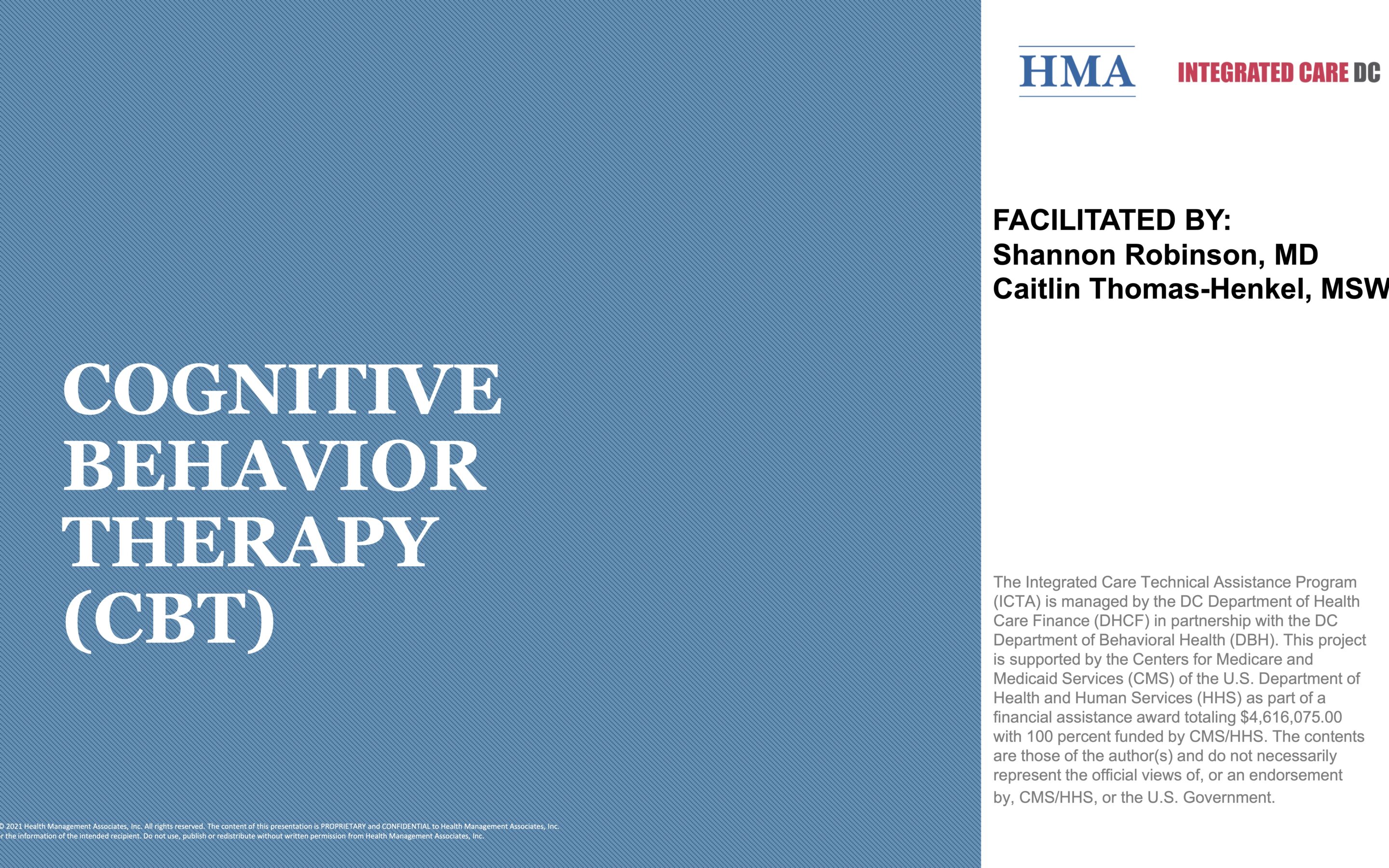
Cognitive Behavior Therapy (CBT)
Cognitive Behavioral Therapy (CBT) is a type of psychotherapeutic treatment that helps people learn how to identify and change maladaptive thought patterns that have a negative influence on behavior and emotions. This short take video will cover the key principles of CBT and a few basic techniques that are utilized for various conditions.Problem Solving Treatment & Tools
Problem Solving Therapy (PST) provides tools to help individuals identify and solve problems that can have a negative impact on their day-to-day lives. PST improves an individual's overall quality of life, treats depression and other conditions. It is based on a model that considers the importance of real-life problem-solving, including managing life stressors when they arise. This short take video covers the fundamental principles of PST and the tools to use in everyday life.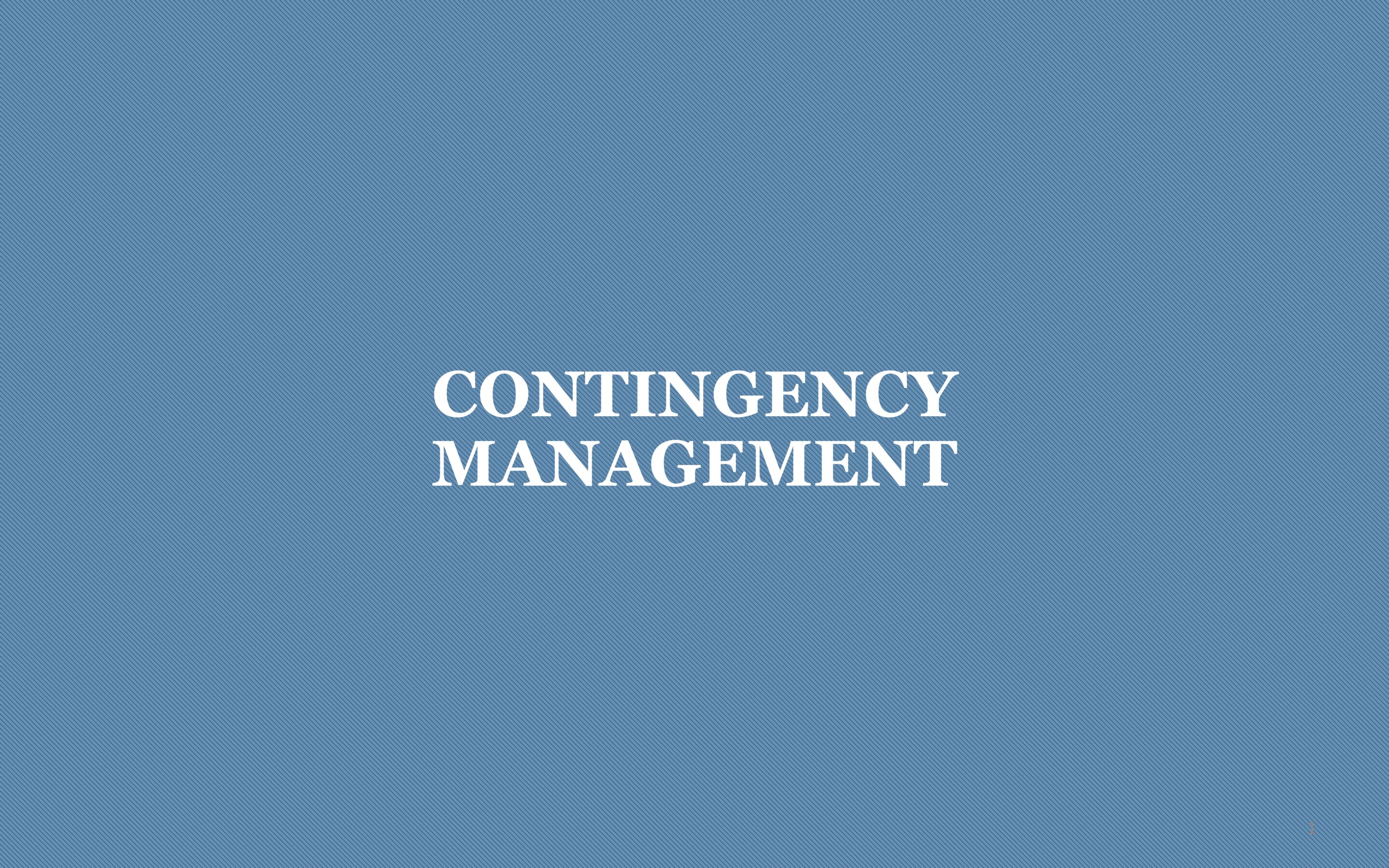
Contingency Management: Underutilized Evidence Based Treatment
Contingency management is an evidence-based treatment plan for substance use disorder. This type of treatment, a major topic in media and public policy circles, promotes behavior change and reinforces positive behaviors. This short take video discusses contingency management treatment in more detail and how to increase its use in more practices.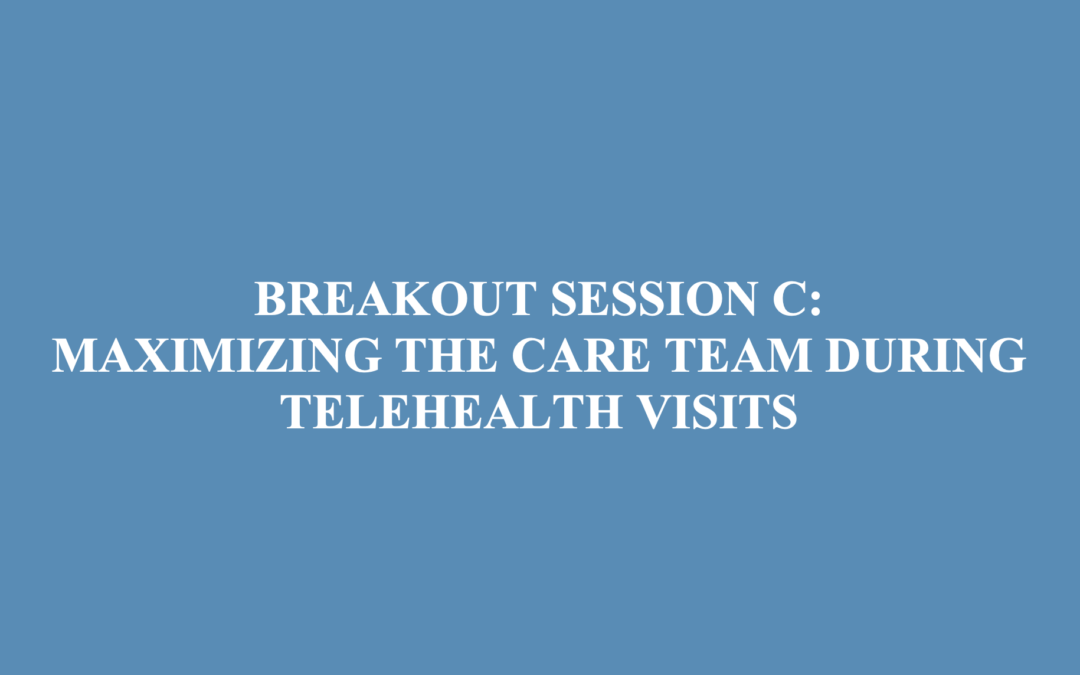
Maximizing the Care Team During Virtual Visits
This session focuses on learning and applying new virtual workflow strategies to engage your entire care team. The session was held live during Telehealth in a Post-Pandemic Era: Sustainable Approaches to Support Integrated Care – Part 2, held on September 29, 2021.Evidence Based Practices Workshop 3 Problem Solving Therapy
Problem-Solving Therapy (PST) is a form of therapy that provides people with tools to identify and solve problems that arise from life stressors that can have a negative impact on their day-to-day lives. Its aim is to improve individuals’ overall quality of life and can be used to treat depression, among other conditions. It is based on a model that takes into account the importance of real-life problem-solving including how to manage real-life stressors when they arise. The presentation will cover key PST principles and tools that can be used in everyday life.Evidence Based Practices Workshop 2 Behavioral Interventions for Stress Management
There are many evidence-based techniques that are easy to learn and practice, with good results in individuals struggling with physical and mental health challenges. This workshop with briefly introduce participants to some of the more common and effective practices including progressive muscle relaxation, guided imagery, diaphragmatic breathing, relaxation response, and mindfulness-based stress reduction. Speakers: Shannon Robinson, MD (HMA), Marsha Johnson, MSW, LCSW (HMA)Problem Solving Worksheet
This worksheet guides the clinician and person receiving services in following the seven steps of problem-solving: Identifying the problem Describing the goal Brainstorming solutions Evaluating the pros and cons for each potential solution Choosing the preferred solution Creating a detailed action plan Evaluating the outcome.Relaxation Handout
This patient-facing handout reviews basic steps for meditation, deep breathing, progressive muscle relaxation, and imagery. This can be used when explaining stress reduction techniques to patients.Evidence Based Practices Workshop 1 Cognitive Behavioral Therapy

Viewing Time 1 Hour
Adapting Evidence Based Practices for Integrated Care
This webinar workshop series focuses on key elements of evidence-based practices/treatments to assist providers with achieving successful implementation and outcomes. HMA presenters discuss key components of EBPs including but not limited to training, indicated populations, fidelity assessments, tools, and other relevant topics. This webinar includes an interview with psychologist Jennifer Frey who discusses the ways in which she uses and adapts the EBP of Motivational Interviewing in her work as a behavioral health consultant at Unity. Following this webinar, there is a series of three EBP workshops that includes cognitive behavior therapy, behavioral interventions for stress management trauma-informed care, problem-solving therapy.Integrated Care DC Provider Information Session
Integrated whole-person care has been shown to improve outcomes and increase Medicaid beneficiary satisfaction. We want to support you to enhance your practice’s capability to deliver person-centered care, use population health analytics, and engage leadership to support value-based care. Join us to learn more about provider engagement opportunities for year 2 of the Integrated Care DC Program.TeleHealth Workflow Comparison
Pregnancy and Substance Abuse: A Harm Reduction Toolkit
This toolkit was designed to help community providers care for pregnant and parenting people who use drugs in a holistic manner. The kit includes information about stigma reduction, trauma-informed care, and legal services. While the guide was developed IN NY, there are engagement and other information that is useful regardless of location.Clinical Guidance for Treating Pregnant and Parenting Women With Opioid Use Disorder and Their Infants
SAMHSA supported the development of this guide in 2018 to promote evidence-informed care for pregnant and parenting women who have OUD. It includes modules on prenatal care, postnatal care, infant care, and more.